Hangzhou Hikvision Digital Technology IPCR625 Camera User Manual
Hangzhou Hikvision Digital Technology Co., Ltd. Camera
Users Manual

1
Camera
Network Mini Dome Camera
Quick Start Guide
UD.6L0201B1863A01

Network Bullet CameragQuick Start Guide
2
Quick Start Guide
COPYRIGHT ©2015 Hangzhou Hikvision Digital Technology Co., Ltd.
ALL RIGHTS RESERVED.
Any and all information, including, among others, wordings, pictures,
graphs are the properties of Hangzhou Hikvision Digital Technology
Co., Ltd. or its subsidiaries (hereinafter referred to be “Hikvision”).
This user manual (hereinafter referred to be “the Manual”) cannot
be reproduced, changed, translated, or distributed, partially or
wholly, by any means, without the prior written permission of
Hikvision. Unless otherwise stipulated, Hikvision does not make any
warranties, guarantees or representations, express or implied,
regarding to the Manual.
About this Manual
This Manual is applicable to 25xx Network Camera.
The Manual includes instructions for using and managing the
product. Pictures, charts, images and all other information
hereinafter are for description and explanation only. The
information contained in the Manual is subject to change, without
notice, due to firmware updates or other reasons. Please find the
latest version in the company website
(http://overseas.hikvision.com/en/).
Please use this user manual under the guidance of professionals.
Trademarks Acknowledgement
and other Hikvision’s trademarks and logos are the
properties of Hikvision in various jurisdictions. Other trademarks and
logos mentioned below are the properties of their respective
owners.

Network Bullet CameragQuick Start Guide
3
Legal Disclaimer
TO THE MAXIMUM EXTENT PERMITTED BY APPLICABLE LAW, THE
PRODUCT DESCRIBED, WITH ITS HARDWARE, SOFTWARE AND
FIRMWARE, IS PROVIDED “AS IS”, WITH ALL FAULTS AND ERRORS,
AND HIKVISION MAKES NO WARRANTIES, EXPRESS OR IMPLIED,
INCLUDING WITHOUT LIMITATION, MERCHANTABILITY,
SATISFACTORY QUALITY, FITNESS FOR A PARTICULAR PURPOSE, AND
NON-INFRINGEMENT OF THIRD PARTY. IN NO EVENT WILL
HIKVISION, ITS DIRECTORS, OFFICERS, EMPLOYEES, OR AGENTS BE
LIABLE TO YOU FOR ANY SPECIAL, CONSEQUENTIAL, INCIDENTAL, OR
INDIRECT DAMAGES, INCLUDING, AMONG OTHERS, DAMAGES FOR
LOSS OF BUSINESS PROFITS, BUSINESS INTERRUPTION, OR LOSS OF
DATA OR DOCUMENTATION, IN CONNECTION WITH THE USE OF
THIS PRODUCT, EVEN IF HIKVISION HAS BEEN ADVISED OF THE
POSSIBILITY OF SUCH DAMAGES.
REGARDING TO THE PRODUCT WITH INTERNET ACCESS, THE USE OF
PRODUCT SHALL BE WHOLLY AT YOUR OWN RISKS. HIKVISION SHALL
NOT TAKE ANY RESPONSIBILITES FOR ABNORMAL OPERATION,
PRIVACY LEAKAGE OR OTHER DAMAGES RESULTING FROM CYBER
ATTACK, HACKER ATTACK, VIRUS INSPECTION, OR OTHER INTERNET
SECURITY RISKS; HOWEVER, HIKVISION WILL PROVIDE TIMELY
TECHNICAL SUPPORT IF REQUIRED.
SURVEILLANCE LAWS VARY BY JURISDICTION. PLEASE CHECK ALL
RELEVANT LAWS IN YOUR JURISDICTION BEFORE USING THIS
PRODUCT IN ORDER TO ENSURE THAT YOUR USE CONFORMS THE
APPLICABLE LAW. HIKVISION SHALL NOT BE LIABLE IN THE EVENT
THAT THIS PRODUCT IS USED WITH ILLEGITIMATE PURPOSES.

Network Bullet CameragQuick Start Guide
4
IN THE EVENT OF ANY CONFLICTS BETWEEN THIS MANUAL AND THE
APPLICABLE LAW, THE LATER PREVAILS.
Regulatory Information
FCC Information
Note: This product has been tested and found to comply with the
limits for a Class B digital device, pursuant to Part 15 of the FCC Rules.
These limits are designed to provide reasonable protection against
harmful interference in a residential installation. This product
generates, uses, and can radiate radio frequency energy and, if not
installed and used in accordance with the instructions, may cause
harmful interference to radio communications. However, there is no
guarantee that interference will not occur in a particular installation.
If this product does cause harmful interference to radio or television
reception, which can be determined by turning the equipment off
and on, the user is encouraged to try to correct the interference by
one or more of the following measures:
Reorient or relocate the receiving antenna.
Increase the separation between the equipment and receiver.
Connect the equipment into an outlet on a circuit different from
that to which the receiver is connected.
Consult the dealer or an experienced radio/TV technician for help.
Please take attention that changes or modification not expressly
approved by the party responsible for compliance could void the
user’s authority to operate the equipment.
FCC Conditions

Network Bullet CameragQuick Start Guide
5
This device complies with part 15 of the FCC Rules. Operation is
subject to the following two conditions:
1. This device may not cause harmful interference.
2. This device must accept any interference received, including
interference that may cause undesired operation.
EU Conformity Statement
This product and - if applicable - the supplied
accessories too are marked with "CE" and comply
therefore with the applicable harmonized European
standards listed under the EMC Directive 2004/108/EC, the RoHS
Directive 2011/65/EU, and the R&TTE Directive 1999/5/EC.
2012/19/EU (WEEE directive): Products marked
with this symbol cannot be disposed of as unsorted
municipal waste in the European Union. For proper
recycling, return this product to your local supplier
upon the purchase of equivalent new equipment, or dispose of it at
designated collection points. For more information see:
www.recyclethis.info
2006/66/EC (battery directive): This product
contains a battery that cannot be disposed of as
unsorted municipal waste in the European Union.
See the product documentation for specific battery
information. The battery is marked with this symbol,
which may include lettering to indicate cadmium (Cd), lead (Pb), or
mercury (Hg). For proper recycling, return the battery to your
supplier or to a designated collection point. For more information
see: www.recyclethis.info
This equipment should be installed and operated with a minimum
distance 20cm between the radiator and your body.
Cet équipement doit être installé et utilisé à une distance minimale de
20 cm entre le radiateur et votre corps.

Network Bullet CameragQuick Start Guide
6
Industry Canada ICES-003 Compliance
This device meets the CAN ICES-3 (B)/NMB-3(B) standards
requirements.
This device complies with Industry Canada licence-exempt RSS
standard(s). Operation is subject to the following two conditions:
(1) this device may not cause interference, and
(2) this device must accept any interference, including interference
that may cause undesired operation of the device.
Le présent appareil est conforme aux CNR d'Industrie Canada
applicables aux appareils radioexempts de licence. L'exploitation est
autorisée aux deux conditions suivantes :
(1) l'appareil ne doit pas produire de brouillage, et
(2) l'utilisateur de l'appareil doit accepter tout brouillage
radioélectrique subi, même si le brouillage est susceptible d'en
compromettre le fonctionnement.
Under Industry Canada regulations, this radio transmitter may only
operate using an antenna of a type and maximum (or lesser) gain
approved for the transmitter by Industry Canada. To reduce potential
radio interference to other users, the antenna type and its gain should
be so chosen that the equivalent isotropically radiated power (e.i.r.p.)
is not more than that necessary for successful communication.
Conformément à la réglementation d'Industrie Canada, le présent
émetteur radio peut fonctionner avec une antenne d'un type et d'un
gain maximal (ou inférieur) approuvé pour l'émetteur par Industrie
Canada. Dans le but de réduire les risques de brouillage
radioélectrique à l'intention des autres utilisateurs, il faut choisir le
type d'antenne et son gain de sorte que la puissance isotrope
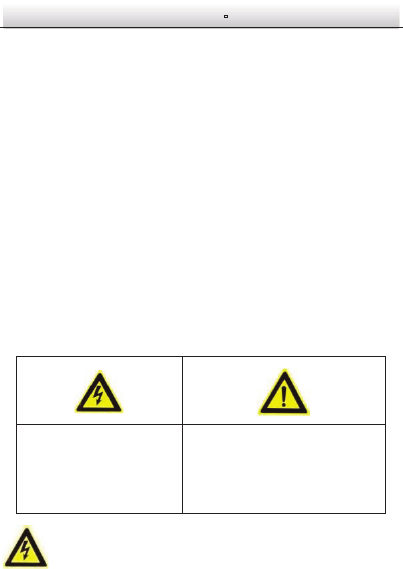
Network Bullet CameragQuick Start Guide
7
rayonnée équivalente (p.i.r.e.) ne dépasse pas l'intensité nécessaire à
l'établissement d'une communication satisfaisante.
Safety Instruction
These instructions are intended to ensure that user can use the
product correctly to avoid danger or property loss.
The precaution measure is divided into “Warnings” and “Cautions”
Warnings: Serious injury or death may occur if any of the warnings
are neglected.
Cautions:
Injury or equipment damage may occur if any of the
cautions are neglected.
Warnings
Warnings Follow these
safeguards to prevent
serious injury or death.
Cautions Follow these
precautions to prevent
potential injury or material
damage.

Network Bullet CameragQuick Start Guide
8
● Proper configuration of all passwords and other security
settings is the responsibility of the installer and/or end-user.
● In the use of the product, you must be in strict compliance with
the electrical safety regulations of the nation and region. Please
refer to technical specifications for detailed information.
● Input voltage should meet both the SELV (Safety Extra Low
Voltage) and the Limited Power Source with 24 VAC or 12 VDC
according to the IEC60950-1 standard. Please refer to technical
specifications for detailed information.
● Do not connect several devices to one power adapter as
adapter overload may cause over-heating or a fire hazard.
● Please make sure that the plug is firmly connected to the power
socket. When the product is mounted on wall or ceiling, the
device shall be firmly fixed.
● If smoke, odor or noise rise from the device, turn off the power
at once and unplug the power cable, and then please contact
the service center.
Cautions
● Make sure the power supply voltage is correct before using the
camera.
● Do not drop the camera or subject it to physical shock.
● Do not touch sensor modules with fingers. If cleaning is
necessary, use clean cloth with a bit of ethanol and wipe it
gently. If the camera will not be used for an extended period,
please replace the lens cap to protect the sensor from dirt.

Network Bullet CameragQuick Start Guide
9
● Do not aim the camera at the sun or extra bright places.
Blooming or smearing may occur otherwise (which is not a
malfunction), and affect the endurance of sensor at the same
time.
● The sensor may be burned out by a laser beam, so when any
laser equipment is in using, make sure that the surface of
sensor will not be exposed to the laser beam.
● Do not place the camera in extremely hot, cold (the operating
temperature shall be-30°C ~+60°C, or -40°C ~ +60°C if the
camera model has an “H” in its suffix), dusty or damp locations,
and do not expose it to high electromagnetic radiation.
● To avoid heat accumulation, good ventilation is required for
operating environment.
● Keep the camera away from liquid while in use.
● While in delivery, the camera shall be packed in its original
packing, or packing of the same texture.
● Regular part replacement: a few parts (e.g. electrolytic
capacitor) of the equipment shall be replaced regularly
according to their average enduring time. The average time
varies because of differences between operating environment
and using history, so regular checking is recommended for all
the users. Please contact with your dealer for more details.
● Improper use or replacement of the battery may result in
hazard of explosion. Replace with the same or equivalent type
only. Dispose of used batteries according to the instructions
provided by the battery manufacturer.

Network Bullet CameragQuick Start Guide
10
● If the product does not work properly, please contact your
dealer or the nearest service center. Never attempt to
disassemble the camera yourself. (We shall not assume any
responsibility for problems caused by unauthorized repair or
maintenance.)

Network Bullet CameragQuick Start Guide
11
Table of Contents
1 Appearance Description ............................................................... 12
2 Installation .................................................................................... 15
2.1 Ceiling Mounting ........................................................... 16
2.2 Ceiling Mounting with a Gang Box ................................ 19
2.3 Pendent Mounting ........................................................ 21
2.4 Wall Mounting .............................................................. 23
2.5 Install the Micro SD Card ............................................... 25
3 Setting the Network Camera over the LAN .................................. 27
3.1 Wiring ........................................................................... 27
3.2 Activating the Camera ................................................... 28
3.2.1 Activation via Web Browser ................................ 28
3.2.2 Activation via SADP Software ............................. 30
3.3 Modifying the IP Address .............................................. 31
4 Accessing via Web Browser .......................................................... 33
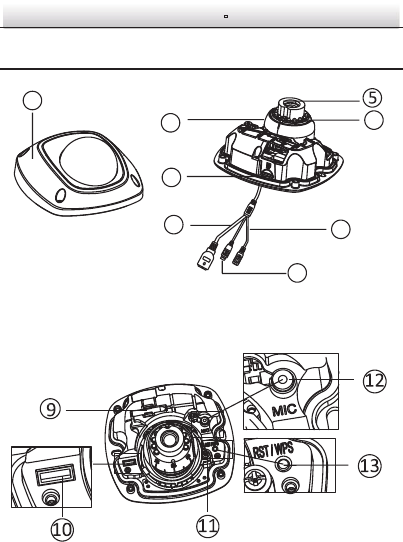
Network Bullet CameragQuick Start Guide
12
1 Appearance Description
Overview (1) Figure 1-1
Overview (2) Figure 1-2
8
4
2
1
3
7
6

Network Bullet CameragQuick Start Guide
13
Physical Description Table 1-1
No.
Description
1 Front Cover
2 Dome Drive
3 Micro SD Card Slot
4 Network Cable
5 Lens
6 IR LED
7 Power Cable
8 Audio/Alarm Cables
9 Wi-Fi Antenna
10
Serial Port Interface
11
Hex Screw
12
MIC
13
RESET/WPS Button
v Press RESET about 10s when the camera is powering on or
rebooting to restore the default settings, including the user
name, password, IP address, port No., etc.

Network Bullet CameragQuick Start Guide
14
v No.8 is the audio/alarm cable interface, of which the “I” mark
connects to the alarm input, the “o” mark connects to the
alarm output, the “GND” mark connects the grounding, and the
“A” mark connects the audio output.
v WPS (Wi-Fi Protected Setup, also known as AOSS or QSS) is a
computing standard that attempts to allow easy establishment
of a secure wireless network. Refer to user manual for details.
v A wireless router with the WPS function is required to enable
the WPS function of the camera. Refer the steps below.
Steps:
Press the WPS button on the router. 1.
Press the WPS button (about 2s) on the camera within 120s 2.
you enable the WPS of the router to join in the wireless
network.
§ The WPS button works as a reset button only when you
press it when the camera is powering on.
§ Press the WPS button on the camera, and then press the
WPS button on the router will establish a connection as
well, and the expire time of WPS connection on the
camera is 120s.
§ The link indicator blinks if the wireless connection is
succeeded.

Network Bullet CameragQuick Start Guide
15
2 Installation
Before you start:
● Make sure the device in the package is in good condition and all
the assembly parts are included.
● The standard power supply is 12V DC or 24V AC, please make
sure your power supply matches with your camera.
● Make sure all the related equipment is power-off during the
installation.
● Check the specification of the products for the installation
environment.
● Make sure that the wall is strong enough to withstand four
times the weight of the camera and the bracket.
For the camera that supports IR, you are required to pay attention to
the following precautions to prevent IR reflection:
● Dust or grease on the dome cover will cause IR reflection.
Please do not remove the dome cover film until the installation
is finished. If there is dust or grease on the dome cover, clean
the dome cover with clean soft cloth and isopropyl alcohol.
● Make sure that there is no reflective surface too close to the
camera lens. The IR light from the camera may reflect back into
the lens causing reflection.
● The foam ring around the lens must be seated flush against the
inner surface of the bubble to isolate the lens from the IR LEDS.
Fasten the dome cover to camera body so that the foam ring
and the dome cover are attached seamlessly.
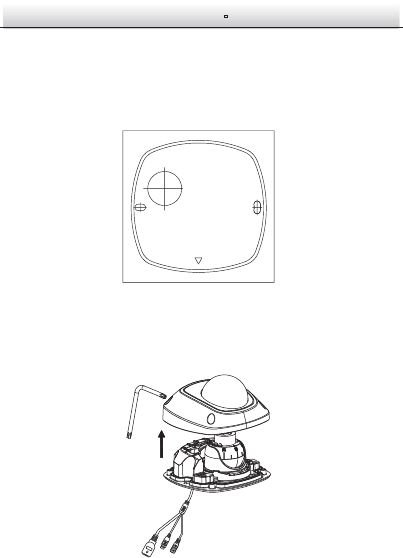
Network Bullet CameragQuick Start Guide
16
Ceiling Mounting 2.1
Steps:
1. Drill the screw holes and the cable hole in the ceiling according
to the supplied drill template.
Drill Template Figure 2-1
2. Loosen the set screw on the front cover to disassemble the
camera with the supplied Allen key.
Disassemble the Camera Figure 2-2
Drill Template
A
1 1
Hole A :for cables routed through the wall
Screw hole1 :for Mounting Base
FRONT
Code:194101278
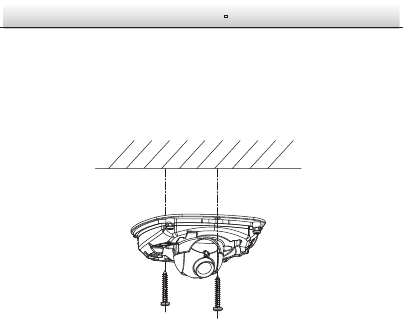
Network Bullet CameragQuick Start Guide
17
3. Hammer the plugs of the expansion screws to the ceiling.
4. Connect the power cable, network cable, and the audio/alarm
cables.
5. Fix the camera body to the ceiling with the supplied expansion
screws.
Fix the Adapter Plate Figure 2-3
6. View the image via the web browser.
7. Slightly loosen the hex screw beside the WPS/RESET button to
adjust the surveillance angle.
8. Use the supplied adjusting tool to adjust the pan [ᱡ30ᲄ], tilt
[0~80ᲄ], and rotation direction [0~360ᲄ].
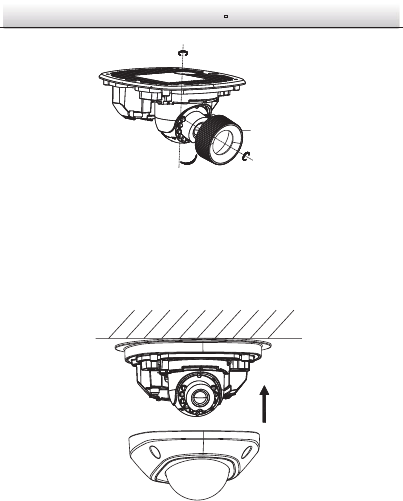
Network Bullet CameragQuick Start Guide
18
3-Axis Adjustment Figure 2-4
9. Tighten the hex screw to fix the well-adjusted surveillance angle.
10. Align the front cover to the dome drive and tighten the set
screws on the front cover.
Install the Front Cover Figure 2-5
11. Tear off the protection film softly to complete the installation.
Adjusting Tool
Rotation
Tilt
Pan
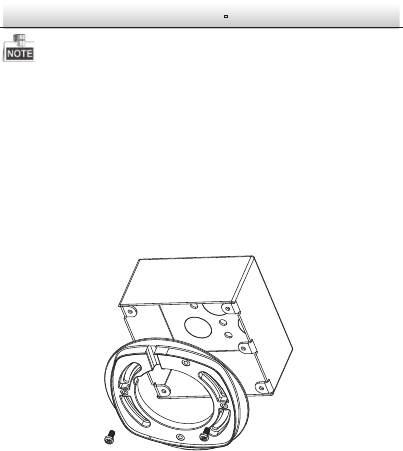
Network Bullet CameragQuick Start Guide
19
l Do not tear off the protection film until the installation is
completed.
l Do not touch the inside face of the bubble with your hands.
Ceiling Mounting with a Gang Box 2.2
Steps:
1. Fix the adapter plate to the gang box with the supplied PM4X8
screws.
Fix the Adapter Plate Figure 2-6
2. Fix the dome drive to the adapter plate with the supplied PM4X8
screws.
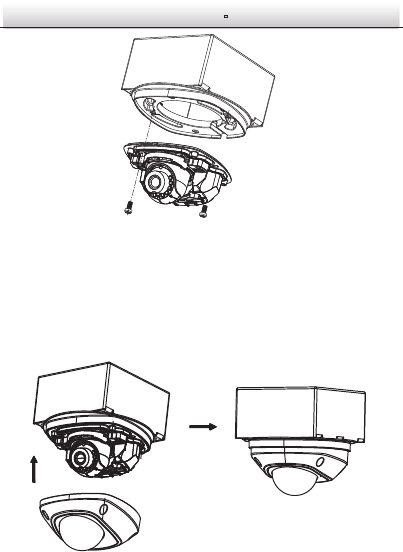
Network Bullet CameragQuick Start Guide
20
Fix the Dome Drive Figure 2-7
3. Connect the power cable, network cable, and the alarm/audio
cables.
4. Align the front cover to the dome drive and tighten the set
screws on the front cover.
Install the Front Cover Figure 2-8

Network Bullet CameragQuick Start Guide
21
5. Tear off the protection film softly to complete the installation.
l Do not tear off the protection film until the installation is
completed.
l Do not touch the inside face of the bubble with your hands.
Pendent Mounting 2.3
Steps:
1. Install the bracket to the ceiling with the supplied screws in the
bracket package.
You need to purchases a pendant bracket separately if pendent
mounting is adopted.
2. Fix the camera body to the pendent bracket with the supplied
PM4X8 screws.
Fix the Adapter Plate Figure 2-9
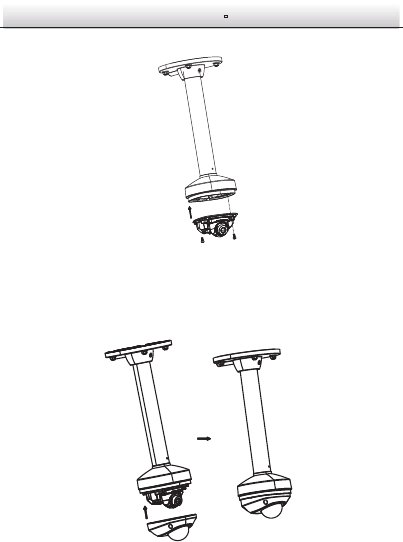
Network Bullet CameragQuick Start Guide
22
3. Install the dome drive to the adapter plate.
Fix the Dome Drive Figure 2-10
4. Align the front cover to the dome drive and tighten the set
screws on the front cover to complete the installation.
Install the Front Cover Figure 2-11
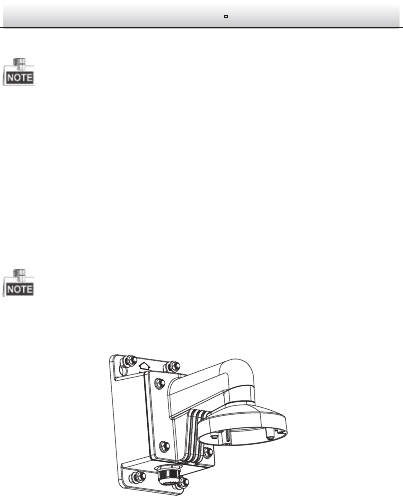
Network Bullet CameragQuick Start Guide
23
5. Tear off the protection film softly to complete the installation.
l Do not tear off the protection film until the installation is
completed.
l Do not touch the inside face of the bubble with your hands.
Wall Mounting 2.4
Steps:
1. Install the wall bracket to the wall with the supplied screws in
the wall bracket package.
You need to purchases a wall bracket separately if wall mounting is
adopted.
Install Wall Bracket Figure 2-12
2. Fix the adapter plate to the wall bracket.
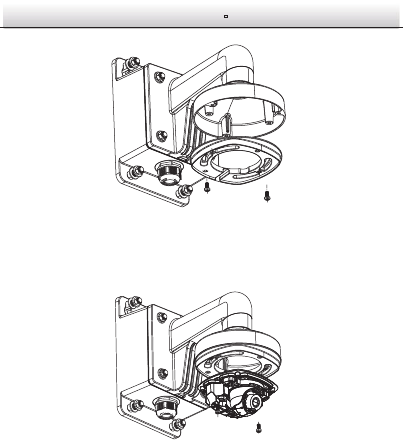
Network Bullet CameragQuick Start Guide
24
Fix the Adapter Plate Figure 2-13
3. Fix the dome drive to the wall bracket with the supplied screws.
Install the Camera Figure 2-14
4. Align the front cover to the dome drive and tighten the set
screws on the front cover to complete the installation.
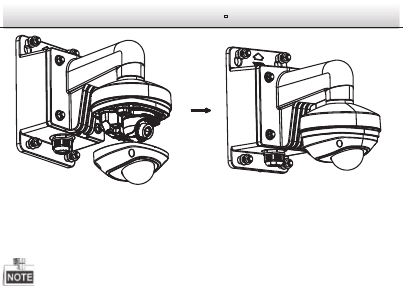
Network Bullet CameragQuick Start Guide
25
Install the Front Cover Figure 2-15
5. Tear off the protection film softly to complete the installation.
l Do not tear off the protection film until the installation is
completed.
l Do not touch the inside face of the bubble with your hands.
Install the Micro SD Card 2.5
This series of camera supports local storage, please refer to the
following steps to install the micro SD card.
Steps:
1. Remove the front cover by loosening the set screws on it.
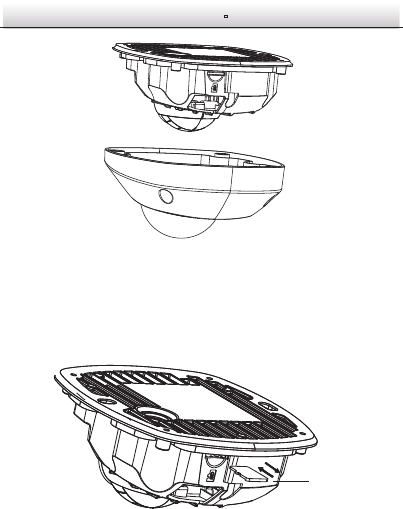
Network Bullet CameragQuick Start Guide
26
Remove the Front Cover Figure 2-16
2. Insert the micro SD card to the card slot until you hear a click.
3. (Optional)Slightly push the inserted micro SD card to uninstall it
from the camera.
Figure 2-17 Install and Uninstall Micro SD Card
Mirco SD Card
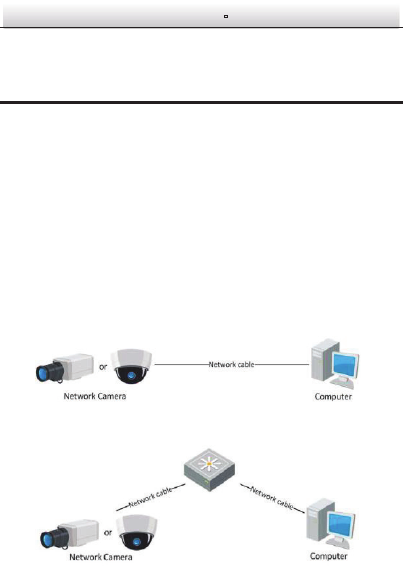
Network Bullet CameragQuick Start Guide
27
3 Setting the Network Camera over the
LAN
Note:
You shall acknowledge that the use of the product with Internet
access might be under network security risks. For avoidance of any
network attacks and information leakage, please strengthen your
own protection. If the product does not work properly, please
contact with your dealer or the nearest service center.
Wiring 3.1
Please connect to the camera to the network according to the
following figures
Connecting Directly Figure 3-1
Connecting via a Switch or a Router Figure 3-2

Network Bullet CameragQuick Start Guide
28
Activating the Camera 3.2
You are required to activate the camera first by setting a strong
password for it before you can use the camera.
Activation via Web Browser, Activation via SADP, and Activation via
Client Software are all supported. We will take activation via SADP
software and Activation via Web Browser as examples to introduce
the camera activation. Please refer to the User Manual of Network
Camera for Activation via Client Software.
Activation via Web Browser 3.2.1
Steps:
1. Power on the camera, and connect the camera to the network.
2. Input the IP address into the address bar of the web browser, and
click Enter to enter the activation interface.
Notes:
l The default IP address of the camera is 192.168.1.64.
l For the camera enables the DHCP by default, you need to
activate the camera via SADP software and search the IP
address.
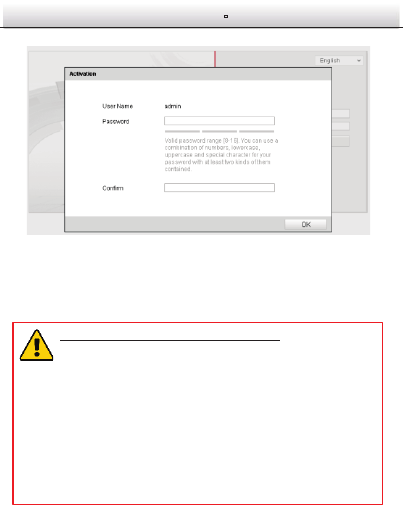
Network Bullet CameragQuick Start Guide
29
Activation Interface(Web) Figure 3-3
3. Create a password and input the password into the password
field.
STRONG PASSWORD RECOMMENDED– We highly
recommend you create a strong password of your own
choosing (using a minimum of 8 characters, including
upper case letters, lower case letters, numbers, and
special characters) in order to increase the security of
your product. And we recommend you reset your
password regularly, especially in the high security
system, resetting the password monthly or weekly can
better protect your product.
4. Confirm the password.
5. Click OK to save the password and enter the live view interface.
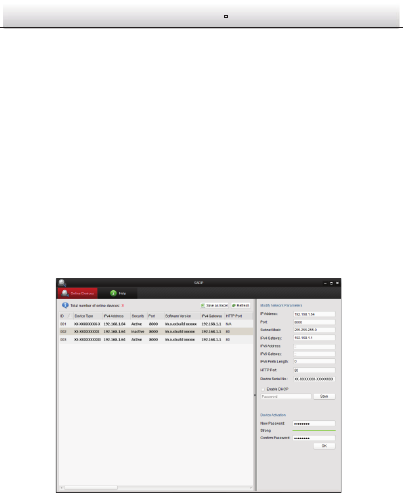
Network Bullet CameragQuick Start Guide
30
Activation via SADP Software 3.2.2
SADP software is used for detecting the online device, activating the
camera, and resetting the password.
Get the SADP software from the supplied disk or the official website,
and install the SADP according to the prompts. Follow the steps to
activate the camera, please refer to the User Manual of Network
Camera for other two activation methods.
Steps:
1. Run the SADP software to search the online devices.
2. Check the device status from the device list, and select the
inactive device.
SADP Interface Figure 3-4
Note:
The SADP software supports activating the camera in batch. Please
refer to the user manual of SADP software for details.
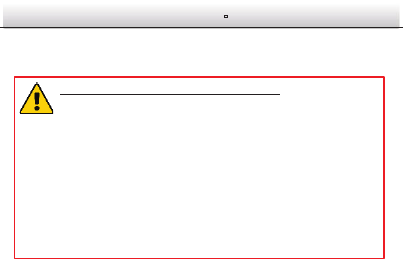
Network Bullet CameragQuick Start Guide
31
3. Create a password and input the password in the password field,
and confirm the password.
STRONG PASSWORD RECOMMENDED– We highly
recommend you create a strong password of your own
choosing (using a minimum of 8 characters, including
upper case letters, lower case letters, numbers, and
special characters) in order to increase the security of
your product. And we recommend you reset your
password regularly, especially in the high security
system, resetting the password monthly or weekly can
better protect your product.
4. Click OK to save the password.
You can check whether the activation is completed on the popup
window. If activation failed, please make sure that the password
meets the requirement and try again.
Modifying the IP Address 3.3
Purpose:
To view and configure the camera via LAN (Local Area Network), you
need to connect the network camera in the same subnet with your
PC. Then, install the SADP software or client software to search and
change the IP of network camera. We will take modifying the IP
Address via SADP software as an example to introduce the IP address
modification.
Steps:
1. Run the SADP software.
2. Select an active device.
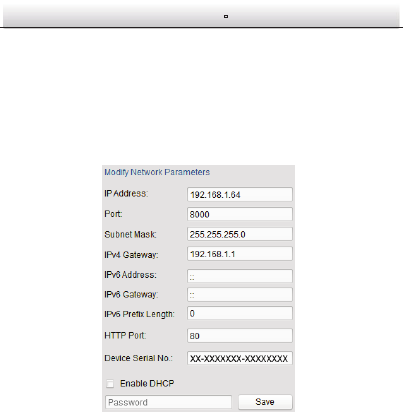
Network Bullet CameragQuick Start Guide
32
Note:
Please refer to Chapter 3.2 to activate the camera if the camera is
inactive.
3. Change the device IP address to the same subnet with your
computer by either modifying the IP address manually or checking
the checkbox of Enable DHCP.
Modify the IP Address Figure 3-5
4. Input the password to activate your IP address modification.
The batch IP address modification is supported by the SADP; please
refer to the User Manual of SADP for details.

Network Bullet CameragQuick Start Guide
33
4 Accessing via Web Browser
System Requirement:
Operating System: Microsoft Windows XP SP1 and above version
CPU: 2.0 GHz or higher
RAM: 1G or higher
Display: 1024×768 resolution or higher
Web Browser: Internet Explorer 8.0 and above version, Apple Safari
5.0.2 and above version, Mozilla Firefox 5.0 and above version and
Google Chrome 18 and above version
Steps:
1. Open the web browser.
2. In the browser address bar, input the IP address of the network
camera, and press the Enter key to enter the login interface.
Note:
l The default IP address is 192.168.1.64.
l If the camera is not activated, please activate the camera first
according to Chapter 3.2.
3. Input the user name and password.
The admin user should configure the device accounts and
user/operator permissions properly. Delete the unnecessary
accounts and user/operator permissions.
Note:
The device IP address gets locked if the admin user performs 7
failed password attempts (5 attempts for the user/operator).
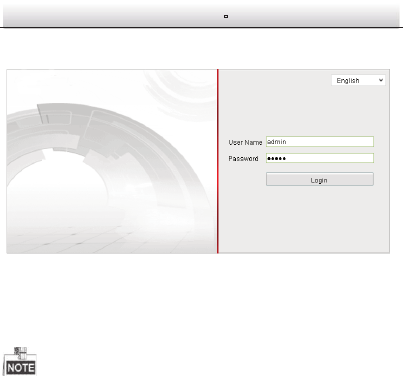
Network Bullet CameragQuick Start Guide
34
4. Click Login.
Login Interface Figure 4-1
5. Install the plug-in before viewing the live video and managing
the camera. Please follow the installation prompts to install the
plug-in.
You may have to close the web browser to finish the installation of
the plug-in.
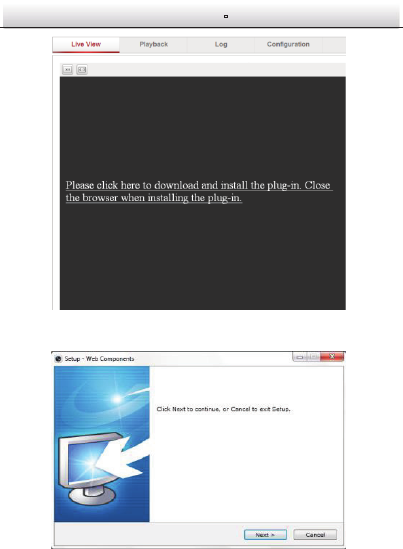
Network Bullet CameragQuick Start Guide
35
Download Plug-in Figure 4-2
Install Plug-in (1) Figure 4-3
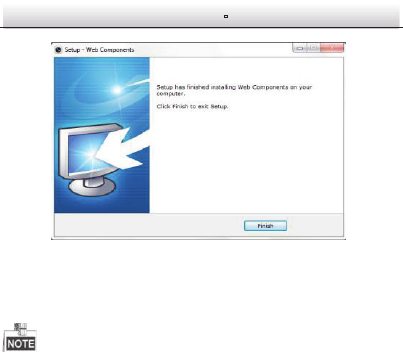
Network Bullet CameragQuick Start Guide
36
Install Plug-in (2) Figure 4-4
6. Reopen the web browser after the installation of the plug-in and
repeat steps 2~4 to login.
For detailed instructions of further configuration, please refer to the
user manual of network camera.

0